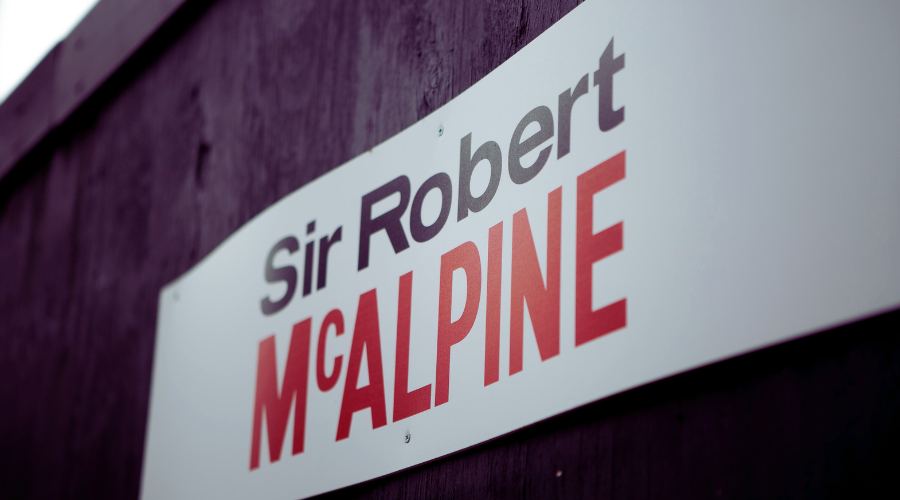
Sir Robert McAlpine, was born in 1847 in Newarthill, Scotland.
He began working in a local mine at age 10. By 17, he apprenticed as a bricklayer while still mining in the winter. In 1868, he started his own building business, later settling in Motherwell and Hamilton, North and South Lanarkshire, respectively.
In 1872, McAlpine secured his first major contract: constructing 100 miners’ cottages in Hamilton for William Smith Dixon, a local industrialist. This success enabled Robert to pursue larger projects in Lanarkshire, including railway construction and iron works.
By 1877, his workforce had grown to several hundred people, with a turnover of £100,000. Despite expanding across Scotland, building over 500 houses and 50 tenements between 1875 and 1878, the economic depression and shrinking coal sector in 1877 led to bankruptcy in May 1880. Although his partnership, McAlpine & Richmond, was bankrupt, he was still able to continue working under his own name with Richmond (the sole owner) remaining in the background. Very different times back then!
McAlpine emerged from bankruptcy in August 1881, resuming his partnership role in McAlpine & Richmond. In 1882, they secured a significant £300,000 (£30 million today) contract to construct Singer Manufacturing Company’s new sewing machine factory in Clydebank. The project was completed in 1885.

His first contract in 1884 involved constructing the original 21-mile segment of the Lanarkshire and Ayrshire Railway.
This marked the beginning of four contracts with the company, solidifying McAlpine’s reputation as a railway contractor. From 1884 to 1904, the firm completed nearly 150 miles of railway lines in Scotland and Ireland.
In 1893, Robert brought his eldest sons, Robert Jr. and William Hepburn, into partnership, forming Robert McAlpine & Sons. His other sons, (Thomas) Malcolm, Alfred, and Granville, joined the partnership in 1905. The company then expanded its portfolio to include reservoirs, docks, and pipelines alongside traditional projects like gasworks, warehouses, and railway stations.
By 1893, the company employed 7,000 people with a turnover of £450,000 (£48 million today).
In 1900, McAlpine had delegated most administrative duties to his sons, though he remained active in significant projects such as the Radnor Park “Holy City” housing development at the Singer works, initiated in 1904. In 1914, McAlpine owned over 1,400 houses and shops in the area.

Robert’s pioneering use of concrete in Scottish construction from the 1870s earned him the nickname “Concrete Bob.” His company later adopted mass concrete and reinforced concrete techniques, obtaining licenses for patented methods.
The first license, for Hennibique’s patent, was managed by the subsidiary McAlpine Hennebique Ferro-Concrete Co Ltd, established in 1907.
In 1918, Robert McAlpine Sr. was granted a baronetcy, and the company was renamed Sir Robert McAlpine & Sons.
Throughout the 1920s and early 1930s, the company expanded its operations across the UK, incorporating several subsidiary companies to manage regional contract work. These limited liability companies included Sir Robert McAlpine & Sons (London) Ltd, (Scotland) Ltd, (Midlands) Ltd, (Newcastle-upon-Tyne) Ltd, (Ireland) Ltd, (Birmingham) Ltd, and Sir Robert McAlpine Properties (Scotland) Ltd.
While the parent company remained a partnership, these new subsidiaries, with partners of Sir Robert McAlpine & Sons serving as directors and shareholders, helped diversify financial risk for large projects. For instance, if a contract belonging to Sir Robert McAlpine & Sons (London) Ltd failed, only that specific company would bear the financial liability, rather than the entire Sir Robert McAlpine & Sons.
In 1922, Sir Robert McAlpine & Sons secured the contract to construct Wembley Stadium and the British Empire Exhibition buildings in London. Later, in 1931, they completed the Dorchester Hotel in London, fully owning it from 1937 to 1976 under the subsidiary Dorchester Hotel Ltd. By 1931, the company was managed by William, Malcolm, and Alfred, as Sir Robert passed away in 1934.

Shortly after, Robert Jr. assumed control of the business but passed away just 13 days later. Subsequently, his brother William McAlpine stepped in as chairman.
In 1956, the company transitioned to limited liability status as Sir Robert McAlpine & Sons Ltd. Then, in 1972, the McAlpine family established Newarthill Ltd, a public company listed on the Stock Exchange, to serve as a holding company for the primary concern and other family-controlled enterprises.
The primary concern returned to private ownership in the mid-1980s and was rebranded as Sir Robert McAlpine Ltd in 1992, with registered offices in Hemel Hempstead, Hertfordshire, England.
Today, Sir Robert McAlpine remains one of the UK’s most reputable contractors having worked on major projects such as the icon Elizabeth Tower and The Royal Albert Hall.
Get industry news in 5 minutes!
A daily email that makes industry news enjoyable. It’s completely free.
